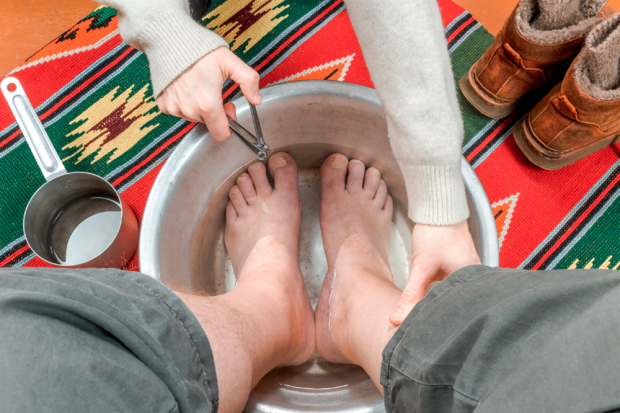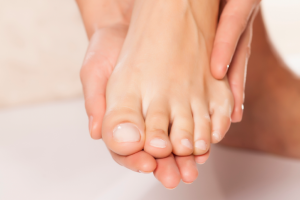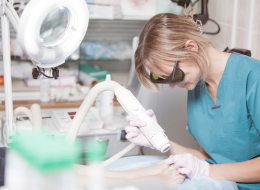On Your Toes 10 Tips For Growing Healthy Toenails
Here's how to grow strong and healthy toenails free from fungus, bacteria, ingrown nails and other conditions that require a visit to a podiatrist.
It doesn’t matter whether you’re a man or a woman: Strong, healthy toenails are a must for overall health and wellbeing. And all it takes to get clear, shiny toenails any podiatrist would be proud of is a few basic maintenance steps you can easily do at home.
1. Daily Cleansing
Bathing your feet once per day using a mild soap not only helps ward off pesky toenail fungus (onychomycosis) and bromodosis, the warm water can help stimulate circulation to your feet and toes, which helps toenails grow healthy and strong. Be sure to scrub your toenails with a foot brush while bathing and thoroughly dry each foot, including between the toes, afterward.
2. Moisturize
One of the easiest ways to keep your toenails in great shape is to practice great dermatology by moisturizing them on a daily basis. Using regular lotion on your feet helps keep the skin around each toenail soft and healthy, while using nail oils that contain quick-absorbing ingredients like jojoba oil keeps your toenails from becoming dry, cracked and brittle.
3. Frequent Trimming
Inspect and trim your toenails with nail scissors or a quality pair of toenail clippers about once a month. It is very important that you trim your toenails properly — straight across, never in a curved shape — to help prevent ingrown toenails and bacterial and fungal infections. You should also never cut your toenails too short, as having a slight bit of nail at the end helps protect the toes from pressure and possible trauma.
4. Filing
Use a fine nail file or very gentle emery board to smooth out any rigid toenail edges, which can help prevent hangnails as well as rips and tears to the nail.
5. Toenail Friendly Diet
Both your fingernails and your toenails are made from a protein called keratin. You can help your body produce healthy amounts of the protein by eating a balanced diet filled with vitamin and nutrient-rich foods like vegetables, fruits, nuts and lean meats. You can also use vitamin or biotin supplements to help boost nail growth, but most doctors and podiatrists agree that eating a healthy diet is the best way to give your body the fuel it needs.
6. Wearing Proper Shoes and Socks
Believe it or not, properly fitted shoes and socks can go a long way toward maintaining clear, shiny and healthy toenails. Socks that are too tight can restrict the blood circulation your nails need to grow strong, while shoes that don’t fit properly can lead to ingrown toenails, black toenails (subungual hematoma), corns, calluses, blisters and other foot issues that can potentially affect the way you walk and therefore put undue pressure on your toenails. Meanwhile, it’s smart to wear flip flops or other protective footwear when you’re in damp public places like gyms, pools and locker rooms to help ward off plantar warts and toenail fungus.
7. Occasional Massage
Whether you spring for a professional rub, receive help from your partner or do it yourself, occasional foot rubs (twice per month or more) help keep the circulation in your feet and toes strong. Good circulation gives your nails a rich blood supply, which helps them maintain a healthy light pink color with a smooth sheen.
8. Treat Yourself To Foot Soaks
It’s always a good idea to indulge in a foot soak every once in awhile. Footbaths are relaxing, help decrease stress and can do wonders for your toenails, as well. Soaking the nails helps loosen dirt and debris that may be lurking in the nail folds, lessens your chance of developing smelly feet and foot fungus infections, and can also be moisturizing if oils are added to the water.
9. Use Caution With Pedicures and Polish
Professional pedicures can leave your toenails vulnerable to toenail fungal infections, and nail techs often cut your cuticles and eponychium (the skin surrounding your nails), which can lead to inflammation and infection. Meanwhile, non-organic nail polish can leave your toenails stained yellow, and acetone nail polish remover can significantly dry out your nails, leading to unattractive peeling and cracking. Therefore, it's best to use caution when treating your feet and toes to pedicures. Try opting for all-natural, organic pedicures and using nail polishes free from toxic ingredients like tolulene, dibutyl phthalate and formaldehyde
10. Frequent Inspections
If you follow the above steps, you will more than likely be much more aware of your toenails and their overall health condition than before you started, but it’s still a good idea to frequently inspect your toenails, which oftentimes are the first place serious health issues show their symptoms. Diseases like diabetes, psoriasis and onychomycosis (toenail fungus) show up on your nails via pits, marks, discoloration and ridges. Being aware of your nails and visiting a podiatrist at the first sign of trouble could save your health and potentially your life.
Notice concerning medical entries:
Articles having medical content shall serve exclusively for the purpose of general information. Such articles are not suitable for any (self-) diagnosis and treatment of individual illnesses and medical indications. In particular, they cannot substitute for the examination, advice, or treatment by a licensed physician or pharmacist. No replies to any individual questions shall be effected through the articles.






